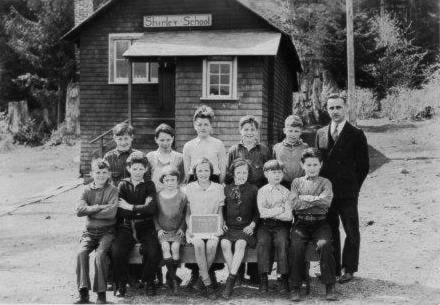Elida Peers | Contributed
While the days of the one-room schoolhouse are long gone, they were certainly a valued part of pioneer life.
Shirley School, built in 1916, stood on land at the corner of West Coast and Sheringham Point roads, a site which encompasses a community park today.
For the pioneer families of Shirley, the schoolhouse became a centre for community gatherings, before the Shirley Community Hall was built.
Ed Banner recalls ta wood-burning furnace for heat at the schoolhouse, and a woodshed and two outhouses in back.
For the Banner kids, who lived a couple of miles west, it was a daily walk to and from school.
While Bob Banner was too young for this photo, he recalls that when the days got too dark in winter, coal oil lamps were used for light.
The Cross kids, living on Sheringham Point Road, all attended this school, from Margaret down to Lorna and Janey.
In this photo, rear left and second from right, are Ronald and Russell Clark, sons of Margaret and Percy Clark (after Margaret Clark was widowed, she became well-known locally as Mrs. Perron). Second from left is Bill Milligan, a son of the Milligan logging family well known in Shirley. In the centre is Charlie Cross, and the teacher is Harry Downard. Front row, second from left is Walt Banner, younger brother of Ed, who went off to war a few years later and returned with a British bride, Joan, who raised a large family in Sooke. Margaret Cross is holding the slate, and is followed by Shirley Banner, sister of Ed, Walt and Bob. Alfred and Edward Stenseth complete the row.
The Arden kids from the Sheringham Point Light were no longer at the school when this photo was taken, though the building of the school in 1916 had heralded great excitement for them when they could walk two miles from the isolated lighthouse and attend a real school.
When enrolment in Shirley decreased, the school closed in 1946, the remaining pupils bused to Muir Creek School, located at Elders’ Camp, and when that school closed in 1954, the kids were bused to Sooke.
After its schoolhouse days, the building shown was rented out briefly as living quarters in the 1950s before dismantled. The decline of population at Shirley stopped long ago, and nowadays the area is home to many families.
•••
Elida Peers is the historian of Sooke Region Museum.
